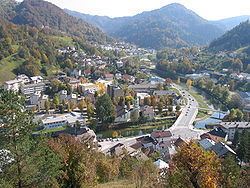Country Region Europe and North America | Area 13.1 km2 | |
 | ||
Map of Idrija
Idrija ([ˈiːdɾija]; Italian and German: Idria) is a town in western Slovenia. It is the seat of the Municipality of Idrija. It is located in the traditional region of the Slovenian Littoral and is in the Gorizia Statistical Region. It is notable for its mercury mine with stores and infrastructure, as well as miners' living quarters, and a miners' theatre. Together with the Spanish mine at Almadén, it has been a UNESCO World Heritage Site since 2012. In 2011, Idrija was given the Alpine Town of the Year award.
Contents
- Map of Idrija
- Vacation guest house rozica in idrija
- Reaky kaos idrija 2010
- Geography
- History
- Legend
- Church
- Notable people
- References
Vacation guest house rozica in idrija
Reaky kaos idrija 2010
Geography
The town of Idrija lies in the Idrija Basin, surrounded by the Idrija Hills. It is traversed by the Idrijca River, which is joined there by Nikova Creek. It includes the hamlets of Brusovše, Cegovnica, Prenjuta, and Žabja Vas close to the town center, as well as the more outlying hamlets of Češnjice, Ljubevč, Kovačev Rovt, Marof, Mokraška Vas, Podroteja, Razpotje, Staje, and Zahoda. The Marof hydroelectric plant is located on the Idrijca River on the northern outskirts of Idrija, between Marof and Mokraška Vas.
History
Mercury was discovered in Idrija (known as Idria under Austrian rule) in the late 15th century (various sources cite 1490, 1492, and 1497). Mining operations were taken over by the government in 1580. The mineral idrialite, discovered here in 1832, is named after the town.
Legend
According to legend, a bucket maker working in a local spring spotted a small amount of liquid mercury over 500 years ago. Idrija is one of the few places in the world where mercury occurs in both its elemental liquid state and as cinnabar (mercury sulfide) ore. The subterranean shaft mine entrance known as Anthony's Shaft (Antonijev rov) is used today for tours of the upper levels, complete with life-sized depictions of workers over the ages. The lower levels, which extend to almost 400 meters below the surface and are no longer being actively mined, are currently being cleaned up.
Church
The parish church in the town is dedicated to Saint Joseph the Worker and belongs to the Diocese of Koper. There are three other churches in Idrija, dedicated to the Holy Trinity, Saint Anthony of Padua, and Our Lady of Sorrows.
Notable people
Notable people that were born or lived in Idrija include:
